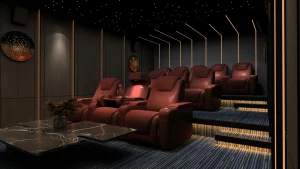Did you know that sound in a film is much more than just music and dialogue. It’s an element that builds emotion, tension, and atmosphere. However, even the best soundtrack loses its impact if played in a room with poor acoustics. Poor sound reflections, echoes, or booming can completely distort the cinematic experience.
For this reason, more and more home cinema enthusiasts and filmmakers are paying attention to room acoustics – both in recording studios and private screening rooms.
Why are room acoustics so important for the perception of film sound?
How to improve the sound of a soundtrack at home?
Dive into the topic and learn why acoustics are so crucial to the sound quality of movies, how to easily improve the sound in your home cinema, and what technologies help you achieve a cinematic effect without having to build a professional studio.
Why are room acoustics so important for the perception of film sound?
Every movie is a complex composition of sounds – from subtle background murmurs to powerful explosions. However, how we perceive them depends largely on the acoustics of the room in which we hear them. When sound waves reflect off the walls, ceiling, and floor, they can create echoes or distortions, causing music and dialogue to lose clarity. The sound loses depth, and emotions lose their intensity.
The solution lies in carefully selected acoustic treatment components. High-quality wall panels, bass traps, and diffusers can significantly improve the perception of film sound. This is where Addictive Sound excels, offering acoustic panels that not only effectively suppress unwanted reflections but also blend harmoniously with the aesthetics of the interior. This is a prime example of how modern technologies can support the emotional experience of a film – without compromising functionality and design.
How to improve the sound of a soundtrack at home?
To create the illusion of a cinematic soundscape at home, good audio equipment alone is not enough. The key lies in the room’s acoustics. Soundproofing the walls and ceiling, using sound-absorbing materials, and dispersing low frequencies allows for a natural and balanced sound effect.
In practice, this means that viewers begin to hear the film as the director intended – with clear dialogue, deep bass, and subtle background details. Proper acoustic treatment makes even quiet scenes seem more realistic, and dynamic action sequences are more impressive. It’s important to emphasize here that modern acoustic panels don’t have to be technically advanced – they can be a decorative element, creating a unique atmosphere for a private cinema.



